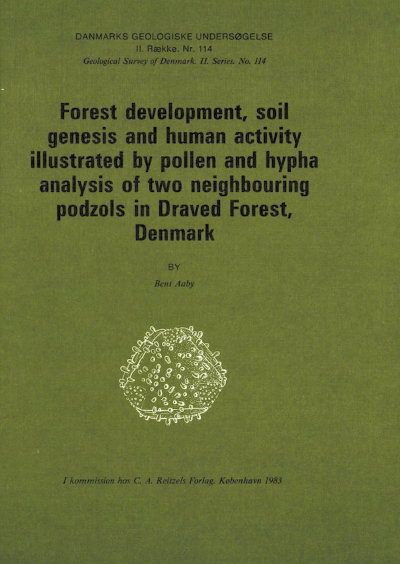Forest development, soil genesis and human activity illustrated by pollen and hypha analysis of two neighbouring podzols in Draved Forest, Denmark
DOI:
https://doi.org/10.34194/raekke2.v114.6905Abstract
A small investigation area, located in an old natural Fagus-Quercus forest, was selected for an analysis of vegetational development, soil genesis, human activity, and interaction between the processes. Podzol soils dominate the investigation area. The thickness of the humus cover varies between 5-52 cm. Two sections were excavated and material collected for pedological and microfossil analysis. Sites only 7 m apart were chosen to illustrate short-distance similarities and dissimilarities in soil development and pollen representation. Sediment accumulation curves are constructed on the basis of historical information on changes in forest composition dating back to AD 1750. Older sediments are dated from their pollen content, assuming a constant pollen influx, similar to the period AD 1750-1980. The accumulation curves reach back to the Subboreal and to the Middle Ages respectively. Relative and absolute pollen diagrams are constructed to show forest development. Concentration diagrams are calculated for the period prior to AD 1750, and an influx diagram covers the period AD 1750-1980.
A primeval Tilia forest dominated the area until Late Subboreal, when human interference is first detected in one of the diagrams. Leaf-hay gathering by shredding, which did not substantially change the forest composition, was practiced until late in the Middle Ages, and the mixed Tilia vegetation persisted until about AD 1650 when the Tilia trees were felled and succeeded by a Quercus-Fagus-Betula vegetation which has dominated the area since. Changes in the use of the forest caused the death of the Tilia forest. Viscum album was present in Draved Forest until the eradication of its host. The presence of Viscum in the l6th-18th centuries indicates that this species tolerates lower summer temperature than earlier supposed. Comparison of the two percentage diagrams shows significant differences in pollen frequency, although the sites are located only 7 m apart. Similar pollen influx rates were calculated for both sites AD 1750-1980. The mean total pollen influx amounted to about 44000 pollen cm-2year-1 or 12-15000 APcorr. cm-2year-1. Distinct influx variations were recognized within smaller time units.
Two types of pollen deterioration, corrosion and thinning, were distinguished and their influence on the pollen spectra analysed. The conclusion being that the pollen spectra are only slightly influenced by pollen deterioration, and differential pollen destruction does not seem to be an important source of error in pollen analysis from the raw humus stage, the arthropod humus stage, and the lumbricid humus stage. Pollen destruction was important only in the lumbricid humus stage, and both types of pollen deterioration are involved.
Fungal hypha analysis includes total length measurements as well as the relative size distribution of hypha fragments. Litter composition strongly influences the annual growth of brown-coloured hyphae. The rate of litter decomposition is another important factor. The hypha production was slow in the lumbricid humus stage and accelerated in the arthropod- and raw humus stages. Hypha fragments in the soil show characteristic length-frequency distributions which indicate comminution by macro- and microarthropods during burial.
The investigation has demonstrated a close relationship between soil development, forest composition and human activity. Anthropogenic disturbance and a changing forest composition accelerate soil development, which is also depending on lithology and topography. The development of a podzol was completed within a period of only 300 years in one of the sections, while it took more than 2000 years to reach the same state of maturity at the other site, only 7 m away.
Downloads
Published
Issue
Section
License
This article is distributed under a CC-BY 4.0 licence, permitting free redistribution and reproduction for any purpose, even commercial, provided proper citation of the original work. Author(s) retain copyright over the article contents.


